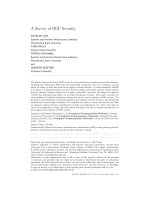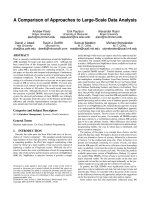A Mess of Greens potx
Bạn đang xem bản rút gọn của tài liệu. Xem và tải ngay bản đầy đủ của tài liệu tại đây (4.06 MB, 280 trang )
U
Waiting to be slow
simmered, these
collard greens could
just as easily
be turnip, mustard,
creasy, or other
leafy greens.
. .
. .
e University of Georgia Press
Athens and London
U
A Mess
of Greens
Portions of this book appeared earlier, in different forms, as “Writing That Old Moonshine
Lit,” Journal of Appalachian Studies, Vol. 13, Issue 1 & 2, Spring/Fall 2007, copyright 2009 by
the Appalachian Studies Association; “Beating the Biscuits in Appalachia,” in Cooking Lessons:
The Politics of Gender and Food, edited by Sherrie A. Inness, Rowman and Littlefield, 2001; and
“Canning Tomatoes, Growing ‘Better and More Perfect Women,’” Southern Cultures, Winter
2009, copyright 2009 by the Center for the Study of the American South, and are reprinted
here with permission.
© 2011 by the University of Georgia Press
Athens, Georgia 30602
www.ugapress.org
All rights reserved
Designed by Mindy Basinger Hill
Set in 11/15.5 Garamond Premier Pro
Printed and bound by Thomson-Shore
The paper in this book meets the guidelines for
permanence and durability of the Committee on
Production Guidelines for Book Longevity of the
Council on Library Resources.
Printed in the United States of America
11 12 13 14 15 P 5 4 3 2 1
Library of Congress Cataloging-in-Publication Data
Engelhardt, Elizabeth Sanders Delwiche, 1969–
A mess of greens : Southern gender and Southern food / Elizabeth S. D. Engelhardt.
p. cm.
Includes bibliographical references and index.
ISBN-13: 978-0-8203-3471-4 (hardcover : alk. paper)
ISBN-10: 0-8203-3471-5 (hardcover : alk. paper)
ISBN-13: 978-0-8203-4037-1 (pbk. : alk. paper)
ISBN-10: 0-8203-4037-5 (pbk. : alk. paper)
1. Food habits—Southern States—History. 2. Food—Social aspects—Southern
States—History. 3. Cooking, American—Southern style—History.
4. Women—Southern States—Social life and customs. 5. Southern States—Social life and
customs. 6. Southern States—Social conditions—History. I. Title.
GT2853.U5E64 2011
394.1'20975—dc23 2011012367
British Library Cataloging-in-Publication Data available
ISBN for this digital edition: 978-0-8203-4187-3
For my mother, ,
whose macaroni and cheese recipe it really is
U
This page intentionally left blank
ix
Whose Food, When, and Why?
Longing for Corn and Beans
Moonshine: Drawing a Bead
on Southern Food and Gender
Biscuits and Cornbread: Race, Class, and
Gender Politics of Women Baking Bread
Canning Tomatoes:
Growing “Better and More Perfect Women”
Will Work for Food:
Mill Work, Pellagra, and Gendered Consumption
Cookbooks and Curb Markets:
Wild Messes of Southern Food and Gender
Market Bulletins:
Writing the Mess of Greens Together
with a leadership group for at-risk girls in West Virginia.
Whether we are dining around a campre or at a picnic table, no meal at High
Rocks begins without a round of “gratefuls,” in which anyone is free to oer
thanks to anyone or anything that happened during the day. Having grown
up around a southern table whose meals started with a blessing, gratefuls feel
a lot like saying grace, except they have a better sense of humor. Inevitably,
gratefuls range from the serious to the silly. Book writing, for me, amasses the
same range of thanks.
First and foremost, I am grateful to the people around the region who le
their stories and recipes to history and who became the subjects of this book.
I am amazed by their resourcefulness and courage. Included with them are the
librarians and archivists who helped preserve those documents—and without
whom my research would have suered. I especially thank Andrea Cantwell
and the sta at the University of Arkansas, Shannon Wilson and the sta of
Berea College’s Hutchison Library, everyone at Mississippi State University’s
Special Collections and University Archives, sta at the Southern Histori-
cal Collection at the University of North Carolina at Chapel Hill, Boyd D.
Cathey and the sta at the North Carolina State Archives, public librarians
at the Chattanooga Public Library, Henry Fulmer and the rest of the South
Caroliniana Library, and volunteers at the Henderson County Genealogical
and Historical Society.
My academic home, the Department of American Studies at the University
of Texas at Austin has hosted both quirky meals and my quirky projects. I
am deeply grateful to be around the table with Bob Abzug, Cary Cordova,
Janet Davis, Steven Hoelscher, Randy Lewis, Nhi Lieu, Stephen Marshall, Je
Meikle, Julia Mickenberg, Naomi Paik, Mark Smith, and Shirley ompson,
x
as well as sta members Stephanie Kaufman, Cynthia Frese, Ella Schwartz,
and the incomparable Valeri Nichols-Keller. anks always go to my mentor,
Frances Smith Foster. It has been enormously helpful and inspirational to
be a member of the Southern Foodways Alliance. My new co-conspirators
in the sister organization, Foodways Texas, are ready for me to be done with
this and turn to our next projects; they inspire me as well. Students, graduate,
undergraduate, and especially the members of the Republic of Barbecue team,
made me an altogether better scholar, and I am grateful to them.
e Writers’ Colony at Dairy Hollow, in Eureka Springs, Arkansas, knew
they gave me a fellowship to work on this project. So did the University of
Texas, through the Dean’s Fellowship program. e lodge at Charit Creek in
Tennessee and the ne home of Jessica Swigger in Cullowhee, North Carolina,
gave me the same luxury, albeit less formally. I ocially thank all of them.
Very great appreciation goes to John T. Edge and Marcie Cohen Ferris. Not
only are they fellow members of the Southern Foodways Alliance, who were
among the rst to hear me talk about this research, but also, they and other
anonymous readers helped make this book manuscript much better than it
would have otherwise been. I am also grateful to the tag team of Erika Ste-
vens and Laura Sutton who, along with the rest of the University of Georgia
Press, shepherded this manuscript along its way. I thank editors at Southern
Cultures and the Journal of Appalachian Studies, as well as anthologists Sherrie
Inness and Ronni Lundy, all of whom read and helped improve earlier, smaller
portions of this work. Psyche Williams-Forson and Carolyn de la Peña both
helped me at crucial points in this research, with friendship and inspired
intellectual conversation.
Most importantly, Betty and Bob Delwiche, my parents, and Imogene
Eaker, my godmother, were always game to answer my strange food questions
(including “Did you ever eat ddleheads?”; “Where exactly did the solder go
on the can?”; and “In which cemetery is that female moonshiner buried?”).
Jennifer Steadman, Julie Clarenbach, Jolie Lewis, Cynthia Riley, and Jaime
Madden took me out for many a hike or walk aer too much southern food
xi
or too much writing about southern food. Although Cynthia might consider
adopting a name that begins with a J, I am grateful to all of them.
Finally, I want to thank my h-grade school picnic. To celebrate “pioneer
days” in the mountains of North Carolina, it featured girls packing baskets of
homemade food on which boys bid. at made me annoyed enough to start
asking why women were expected to cook and have their worth judged by their
food skills—and apparently enough to write a book about it years later. More
importantly, though, the picnic made me ask my grandmother, Iva Sanders
Whitmire, to teach me to cook her famous fried chicken and to bake biscuits.
We stood in her kitchen, laughing, talking, and cooking—and for that lesson,
which completely turned my ten-year-old’s feminist anger into equally feminist
appreciation, I am profoundly grateful to her and to the public school system
of Hendersonville, North Carolina.
This page intentionally left blank
U
delphia and started down the Trans-Allegheny trail, heading for South Caro-
lina. By the s, they had moved up into the North Carolina mountains to
a series of communities in Transylvania and Henderson counties—uebec,
Toxaway, Brevard, Hendersonville. Most of them never le. ey worked in
timber, tannin, and the later paper factories; kept boarders; had small gen-
eral stores; and generally did what they could to survive. ey helped found
churches and build schoolhouses; they farmed in small ways and kept garden
patches. For more than two hundred years, my family practiced and perfected
late-summer, southern meals to share. Surely they cooked real southern food
done right. Clearly, it must have been authentic and pure; the nostalgia we
feel for it, uncomplicated.
From the Fourth of July through Labor Day, with birthdays and visits in
between, any weekend could bring a reason to gather, talk, and eat. e get-
together could take place at a picnic shelter up in the forest (whether Pisgah,
the Nantahalas, or the Smokies), beside the lake at Camp Straus (where present
and former employees of the local paper company could play), or simply in the
kitchen of my grandmother, Iva Sanders Whitmire (–). Regardless,
certain foods always made an appearance. Green beans, picked and snapped
Whose Food,
When, and Why?
U
earlier in the day and then cooked long and seasoned with ham, graced the
table. Silver queen corn joined the beans; both were almost always from Uncle
Jerry and Aunt Betty’s garden. Tomatoes thickly sliced and watermelon sliced
even thicker added color. Fried chicken was piled high, hot from the cast-iron
skillet, lightly battered, pan fried, and juicy. From the same skillet came fried
okra and fried squash. Biscuits with homemade apple jelly or blackberry jam
accompanied the meal. Canned by my grandmother, Uncle Joe, or Uncle Jesse
(who was not my uncle in terms of blood but in every other way), the jellies
and jams always had handmade labels. Each year’s batch held stories of hidden,
pick-your-own farms or discoveries of patches by the side of the road. Late
summer meals oen meant the rst taste of avors that kept us company all
winter.
Potato salad and slaw lled large bowls in summer, cutting down on heat
in kitchens. My family was particular not only about how to dress the slaw—
Duke’s mayonnaise, vinegar, milk, salt, sugar, and pepper—but also about how
to cut the cabbage. We used a paring knife (my grandmother’s blade was almost
gone from years of sharpening) to ake o the small bits of cabbage between
thumb and knife blade. It took at least half an hour to do a head of cabbage
this way. Chopping, slicing, or—heaven forbid—using a food processor was
frowned upon. Although I have asked my mother and aunts, no one knows if
this came from a desire to achieve a particular taste or if it was the only knife
my grandmother had and, thus, how she always did it. Whatever the reason,
we all agree the slaw somehow came out better that way—the nal arbiter of
any family’s favored food practices.
On special occasions, the day ended with homemade peach ice cream—
my dad, the chemical engineer, supervised that job, his knowledge of ice and
rock salt in combination outweighing his perceived-as-unfortunate childhood
outside western North Carolina. e freestone peaches came from down
the mountain in South Carolina, and the ice cream was cranked by hand
with cousins and uncles all taking turns. Electric cranking ice cream mixers
have been moderately tolerated in later years—but, to my family’s mind, the
kitchen counter, computerized, mechanized appliances that whir and buzz
and automatically freeze the ingredients hard have nothing to do with real
peach ice cream. Pitchers of cold, sweet tea sat nearby to refresh the tired and
impatient ice cream makers.
Variations of that meal were being enjoyed by families at the next picnic
shelters over, by mountain residents in earlier decades, and by southerners
across the region. Your family may have similar memories and menus. A closer
look at the meal, though, reveals four dilemmas that are at the heart of this
book—and they are why I am telling you so much about my own particular
family traditions here at the beginning of a project whose chapters are not so
much about my personal history as they are about a broad story of food and
gender in the southern United States during a crucial transition period of the
s through the s.
e turn-of-the-century South existed in a troubled relation to emerging
national markets and visions of a new America. Convulsed by the legacies of
Reconstruction and solidifying the era of Jim Crow, southerners interacted
against a background of mob violence and lynching. Women of dierent
races came together in kitchens—oen as servants and mistresses—but also as
people with shared tastes and ingredients. Meanwhile, much of white America
was gripped by nostalgia for the plantation South—the blockbuster movie
Birth of a Nation swept the country and “Mammy’s cooking” became a cen-
tral image of the nostalgia. Corporations responded, creating gures such as
Aunt Jemima and Uncle Ben to bring the plantation into kitchens across the
country. But much of the celebration involved a mythic South, like that in the
following decades’ Gone With the Wind, existing more in the cultural imagi-
nation of the time than on the ground. Actual southern communities faced
devastating environmental change brought by textile mills, the soil-exhausting
sharecropping economy, and the exportation of raw materials such as timber,
paper, cotton, and tobacco, which made for a painful transition to a money
economy.
uestions of class and social hierarchies in this new economy played
out on the pages of community cookbooks produced by various churches,
women’s clubs, and charitable organizations; in the booths of curb markets
and club exhibits; and in the letters and photographs exchanged across the
region. A combination of climate, stubborn individualism, economic necessity,
and regional pride held together “the South” even as race, class, and gender
threatened to pull it apart—and writers of novels, short stories, and poems
recorded the tensions. As today’s South and the United States as a whole ever
more fully enter global markets and engage shiing denitions of region, race,
class, and gender, the South comes along with us. We can see how this
particular past informs the present in that seemingly simple family meal that
nonetheless hides complicated questions of dening the South, balancing
technology and nostalgia, recognizing racial and ethnic diversity, and deploy-
ing gender in its dishes and foodways.
First, my family’s favorite summer meal was simultaneously local and re-
gional—as a result, it helps us ask how the South gets dened, by whom,
at what time, and why it matters. If pressed, members of families like mine
might describe themselves with several adjectives: “North Carolinians,” for
instance, because there is pride of state here. e s-era War on Poverty
established the federal Appalachian Regional Commission and coined a term
for an identity. In the intervening decades, my family has slowly adopted the
word “Appalachian” to connect our experience with those of other moun-
tain residents. In addition, “American” might be listed. Perhaps because of
my family’s mountain roots, which meant divided loyalties in both present
and past politics and a strong sense of inclusion for all, we have never been a
Confederate ag–waving crowd. Yet I did grow up knowing that I was not
Yankee or Midwestern or from some generic place, so the adjective that is
mostly unsaid, but that gets applied to us and shapes our senses of self even
when we resist it, is “southern.”
In the meal, you see visible expressions of our background regional iden-
tity. Fresh sweet corn and green beans were part of our celebration, but they
would t just as well on tables in Alabama, Texas, or Virginia (or possibly my
father’s native Wisconsin, for that matter, but more on that in a moment).
Watermelon did not grow especially well in the mountains but came to us from
other southern elds. Our preference for South Carolina peaches could just
as easily have been lled by the fabled Georgia peach or the Texas varietals.
e methods of cooking—frying cornmeal-dipped okra and mixing fresh and
home-canned foods on the table—spoke to larger regional food practices.
Even the foodways, the practices and customs around providing, preparing,
and sharing the food, with the emphasis on female cooks and family-food-
centered celebration, placed this particular meal in the U. S. South.
Yet, if you quizzed members of the family about where we are from, the
most likely answer would be more specic: “the mountains of North Carolina”
or even “the mountains of western North Carolina.” A subtle change, putting
“mountains” rst emphasizes how important they are in terms of loyalty and
love of place. At the same time, making mountains the most important part
of the phrase recognizes the marginalization of Appalachia and its foodways
from the rest of the state and the region. North Carolina has never quite known
what to do with its mountains—geographically far from the state capital, they
oen are far down on the state’s priority list as well. For my family and others,
the mountains are the most relevant identity possible. Yet the shared meal
reected that less than it could. While garden vegetables cooked in a kitchen
no more than ve hundred yards from where they were grown achieved a
degree of closeness that local food advocates champion, even more local foods
could have been on the table but were not. I could have listed heritage items
that in combination made the location of our meals in the Blue Ridge Moun-
tains undeniable. Foods foraged from the particular mountain environment
have long been part of my family’s table—ramps, hickory nuts, persimmons,
mountain trout, and wild berries—and we still eat many of them. Traces of the
local were present: the ears of corn and mounds of beans, although they spread
across the country (even to Wisconsin’s gardens), hinted at deeply buried local
connections as my family lived in the heart of Cherokee land, whose tribal
origin story of Selu was one of corn mother and companion beans.
Although Tennessee food scholar Fred Sauceman claims such foraging
connections are hallmarks across the South — that, indeed, “Southerners have
pickled watermelon rinds, made wine out of corn cobs, stewed mudbugs, killed
spring lettuce with vinegar and bacon grease, and sautéed dandelion greens,
thereby creating America’s most diverse indigenous cuisine”
— those items
were not on the table at my family’s summer celebrations. Did we choose to
downplay the economic pressures that led to such resourcefulness? Perhaps,
more simply, we celebrated abundance and good times. Either way, the meal
pointed to aspirations in addition to nostalgia; in other words, it was both
what we believed we were and what we (perhaps subconsciously) wished to
become, members not of a marginalized group, but fellow North Carolinians,
southerners, and Americans, eating a recognized, even storied, cuisine. e
meal and, indeed, this book are more about such aspirations and the stakes
involved in the food choices. As chapter explores, the wild Appalachian,
outside capitalist norms, mobile, free and unpredictable, was a source of great
anxiety in the early century—for people within and out of overlapping com-
munities of Appalachia, the South, and America. Choices made even today
hint at the consequences of old anxieties.
I could have described a dierent but equally historically southern meal.
e greens my family ate most oen were turnip, mustard, or creasy, not col-
lards. My grandmother most preferred to boil her cabbage rather than make
slaw. ey ate dove and lots of squirrel, only rarely having pork barbecue or
buttermilk-soaked fried chicken. e dessert was less likely to be peaches and
more likely to be fried apple pie made with tart dried apples and little sugar.
Biscuits, as chapter explores, were relative newcomers to the mountain table.
ey relied on ingredients not indigenous to the high mountains, but they sat
undeniably in the center of the family table, whereas cornbread was relegated
to supper or breakfast. Family members canned tomatoes or ate them fresh,
but they rarely fried the green ones. Just as my godmother remembers rst
hearing that she was Appalachian in the s, the celebration of fried green
tomatoes as a signature southern food coalesced around Fannie Flagg’s book
of that name as late as the s. In other words, scholars (including me),
media, advertisers, and artists not only excavate food practices, we actively
shape them as well. Our denitions of “true” southern foods change and evolve
constantly, as some foods are lied and celebrated while other equally common
ones stay in the background waiting for their day. A Mess of Greens balances
on shiing ground, resisting what cultural studies scholar Tara McPherson
calls the awed lenticular logic of never seeing the contradictions of southern
societies simultaneously (her term refers to the vintage postcards, called - or
lenticular, which change images depending on how you turn them).
Buried
in food choices are stories of race, class, gender, and social power that are the
topics of this book.
Finally, readers in Louisiana may argue that I cannot claim the meal was
southern without gumbo on the table. Kentuckians want burgoo. Coastal
southerners might insist on shrimp and oysters, or at least rice, in the meal.
Elsewhere, I have agreed with southern food scholars like John Shelton Reed
who argue that barbecue and its variations work like the cheeses of Europe
to map the diverse southern food terroir, the deep connections between food
and place, most precisely. Given the diversity of food and place across the
region, then, does the “southern” in southern food hang together enough
to be useful? Cultural and social historians from Henry Shapiro and Allen
Tullos to the newer Global South anthropologists and literary scholars such
as James Peacock, Kathryn McKee, and Jennifer Greeson have all struggled
with the ways the South both coheres and fragments. For the purposes of this
project, I follow the lead of scholars such as McPherson and Patricia Yaeger
who argue that people recognize the dierences but still act as if the whole
hangs together.
e imagined South is the South, as it were, powerful and
contested. Southern food exists, even if we ght over what counts.
us, while “southern” or “mountain” or “Deep South” or “coastal” food
might seem timeless (or at least stable over hundreds of years), in fact, they
were very much contested and being worked out in the post-Reconstruction
era that is the time period of this project. e following chapters explore West
Virginia, Kentucky, Tennessee, North Carolina, Georgia, South Carolina,
Mississippi, and Arkansas foodways. Virginia and Alabama make appearances.
Louisiana and Florida get admittedly short shri, and, although I have written
elsewhere about Texas, my current home state receives little attention here. I
sincerely hope other books follow to ll in stories from those states. Since my
goal is not to write a broad history of all the food stories that could be told (I
am not even certain that project is possible), I have chosen ve moments and
ve food practices that together illuminate the intimate connections of food,
gender, and region.
In the course of writing my rst book, e Tangled Roots of Feminism, En-
vironmentalism, and Appalachian Literature, I started noticing the times food
worked as a code in women’s letters, diaries, novels, and short stories.
It com-
municated messages about morals, religion, individualism, and education. For
instance, choosing to ferment instead of shipping the corn crop, or deciding
to serve hot breads like cornbread rather than cold sliced breads or beaten bis-
cuits could gain a family the reputation of being unhygienic, morally suspect,
uneducated, and even ungodly. Aspiring instead aer new stoves, cookbooks,
and well-equipped kitchens signaled women ghting for the modern American
soul. In other words, food “means” more than sustenance, and those meanings
shi over time and place. Although everyone must eat, which might suggest
food transcends gender, the histories of women and food mean that, on the
contrary, food is richly gendered. As ideas of community, region, and nation
hang together and fall apart, shiing in meaning depending on who is talking
(for instance, about “America,” “the South,” or “Appalachia”), local people in
local places are dened by and participate in dening the local, national, and
global societies in which they live; this is the cultural work of societies. For
women, especially, food does this cultural work. Breaking the codes of food
begins with its uses, preparations, and costs but ends with the social histories
of race, class, gender, and place that hide in the recipes, ingredients, and food
practices we embrace and use to dene ourselves.
Turning back to the family’s summer feasts, nostalgia and romanticism could
easily emphasize their local and homemade parts, while equally present pro-
cessed ingredients faded into the background. But technologies and consumer-
culture innovations were thoroughly embedded in the meal—from the ice
needed to freeze the ice cream, to the Duke’s Mayonnaise in the slaw and
potato salad, to the White Lily our used in the biscuits. Today, I generally
make my own mayonnaise, in a simple combination of fresh egg yolks, lemon
juice, oil, and salt. But no matter how good, no matter how unprocessed or
basic my version may be, our family nostalgia is instead for the commercially
produced jar from the grocery store.
e history of Duke’s turns out to be precisely the point, though. Founded in
, the original company used recipes for mayonnaise and sandwich spreads
from a woman named Eugenia Duke, a South Carolinian who apparently
needed to make some money by her own means. She began selling sandwiches
to soldiers stationed outside Greenville. Out of the popularity of her products,
Duke’s Sandwich Company formed. e company marketed sandwiches and
spreads to upstate textile workers. Many of Duke’s early customers were mill
women without time or kitchens to x their own meals, so traveling dope
wagons, similar to today’s taqueria trucks, selling Duke’s sandwiches were a
blessing. A second company sold Duke’s Mayonnaise. Although it was later
bought by a Richmond, Virginia, parent company, even today the product
is made in Greenville and marketed regionally. Both companies’ Web pages
celebrate the contributions of Mrs. Duke, but neither gives her much of a
voice.
As chapter explores in the story of early-century tomato-canning clubs,
women and girls eagerly embraced the science and technology of commercial
food production. Subsequent years have threatened to erase their contributions
or make them into safely contained images (such as Mrs. Duke silent on the
Web or girls behind - displays). A Mess of Greens unearths such industrial
stories despite our own seeming eagerness to force women and girls into the
domestic spaces of our collective memories.
A similar reassignment has happened to the food the women and girls
cooked. As much as southern food gets celebrated as the product of southern
women (black and white) cooking in home kitchens, the region was fertile
territory for the founding and expansion of food corporations—Duke’s was
accompanied by White Lily and Martha White Flours, Coca-Cola, and Pepsi,
to name just a few. Mrs. Duke was not the only professional woman involved
in early food companies. Still other women like the mill workers who rst
bought Duke’s spreads created market demand for products. eir daughters
and granddaughters became the brand-loyal consumers like the women in my
family, recognizing and valuing the southern industrial food products. Na-
tional food scholars in the tradition of Harvey Levenstein and Donna Gabac-
cia are right to say transportation, urbanization, and market development
were delayed in the South. Such delays led to an emphasis on home-cooked,
regionally specic foodways, and hence, the persistence of a unique southern
food culture.
e southern food story’s paradox lies in how assiduously the
South worked to catch up, and how much its corporate food products and
their consumers helped solidify the reputation of that southern cuisine that
has persisted in the global marketplace. Southern food, not to put too ne a
point on it, is more of a thing than “Yankee food” or “Midwestern cuisine” or
even “American food.” In John Egerton’s words, “For as long as there has been
a South, and people who think of themselves as Southerners, food has been
central to the region’s image, its personality, and its character.”
By focusing on
the s–s era of economic growth and transformation, A Mess of Greens
examines how people rearranged and rebuilt southern identities within these
new technology- and market-driven worlds. A central claim of this book is
that this is the crucial era to study if we are to understand food and gender in
the twenty-rst-century South.
At the same time, the story does not follow a straight line. With the estab-
lishment and shoring up of segregation in the South, race and class continually
pushed against each other. e era’s food story developed in ts and starts.
For each articulation of anxiety or resolution of tension, another came into
prominence. Moonshine tensions were still in full development while biscuits-
versus-cornbread battles arose, and tomato clubs shared space with both. In
the nal chapters, the mill girls who sacriced nutrition to keep their homes
and dignity and the women who shared conversations at curb markets, in
cookbooks, and by notes sent with seed exchanges were enmeshed in ongoing
debates about authenticity and labor. us, A Mess of Greens roughly begins in









